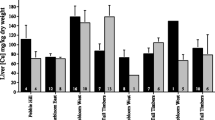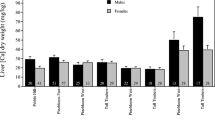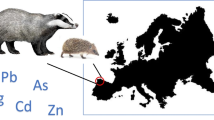Abstract
Metal pollution commonly occurs in many terrestrial environments and may pose a threat for the animals inhabiting such areas. Here, we present concentrations of six metals (cadmium [Cd], copper [Cu], nickel [Ni], lead [Pb], selenium [Se], and zinc [Zn]) in the liver tissues of seven species of mammals obtained from a study that examined the impact of mesopredator removal on northern bobwhite (Colinus virginianus) populations. A total of 1326 samples were collected from 2003 to 2006 at four sites in southwest Georgia and north Florida from nine-banded armadillos (Dasypus novemcinctus), bobcats (Lynx rufus), feral cats (Felis catus), coyotes (Canis latrans), grey foxes (Urocyon cinereoargenteus), opossums (Didelphis virginiana), and raccoons (Procyon lotor). Data from armadillos, bobcats, opossums, and raccoons were published previously to examine age, sex, spatial (between sites), and temporal (between years) variation. In this paper, we present similar comparisons for the remaining three species as well as comparisons of metal concentrations among all seven species. Concentrations of Cu and Pb exhibited strong negative relationships with body weight in coyotes, while Ni was positively correlated with weight in feral cats. Concentrations of these metals, as well as the other two tested (Cd and Zn), were not significantly correlated with one another in any of the three species. The only sex difference in liver metal concentrations was observed in female feral cats, which had higher levels of Pb than did males. Coyotes exhibited significant differences in Cu concentrations between sites and between years (2005 versus 2006). We also found significant differences between sites in Pb concentrations for both feral cats and grey foxes. There were significant differences in metal concentrations among all seven species for all metals except Cd. With the exception of Cd and Se (tested only in bobcats and opossums), a three-way ANOVA with species, year, and site as the three factors revealed significant differences among species for every metal but only a single main effect of year for Cu, and no main effects of site. In sum, our results provide an extensive survey of metal concentrations in a diverse assemblage of mammals and suggest that metal accumulation may be heavily influenced by species identity, which in turn may reflect ecological lifestyle.





Similar content being viewed by others
References
Bekoff, M. (1977). Canis latrans. Mammalian Species, 79, 1–9.
Bekoff, M., & Gese, E. M. (2003). Coyote (Canis latrans). In G. A. Feldhamer, B. C. Thompson, & J. A. Chapman (Eds.), Wild mammals of North America: biology, management and conservation (pp. 467–481). Baltimore, Maryland: The Johns Hopkins University Press.
Bielmyer-Fraser, G. K., Waters, M. N., Duckworth, C. G., Patel, P., Webster, B., Blocker, A., Crummey, C. H., Duncan, A., Nwokike, S., Picariello, C., Ragan, J. T., Schumacher, E. L., Tucker, R., Tuttle, E., & Wiggins, C. (2017). Assessment of metal contamination in the biota of four rivers experiencing varying degrees of human impact. Environmental Monitoring and Assessment, 189, 23.
Bielmyer-Fraser, G. K., Harper, B., Picariello, C., & Albritton-Ford, A. (2018). The influence of salinity and water chemistry on acute toxicity of cadmium to two euryhaline fish species. Comparative Biochemistry and Physiology C, 214, 23–27.
Blagojević, J., Jovanović, V., Stamenković, G., Jojić, V., Bugarski-Stanojević, V., Adnađević, T., & Vujošević, M. (2012). Age differences in bioaccumulation of heavy metals in populations of the black-striped field mouse, Apodemus agrarius (Rodentia, Mammalia). International Journal of Environmental Research, 6, 1045–1052.
Burger, J., & Gochfeld, M. (2001). On developing bioindicators for human and ecological health. Environmental Monitoring and Assessment, 66, 23–46.
Burger, J., Gaines, K. F., Lord, C. G., Brisbin Jr., I. L., Shukla, S., & Gochfeld, M. (2002). Metal levels in raccoon tissues: differences on and off the Department of Energy’s Savannah River site in South Carolina. Environmental Monitoring and Assessment, 74, 67–84.
Davis, W., & Schmidly, D. (1994). The mammals of Texas. Texas Parks and Wildlife Department. Austin: Texas.
Davison, A., & Stromsten, F. A. (1947). Mammalian anatomy with special reference to the cat. New York: McGraw-Hill.
Eisler, R. (1985). Cadmium hazards to fish, wildlife, and invertebrates: a synoptic review. Biological Report 85(1.2), Contaminant Hazards Review No. 2, U.S. Fish and Wildlife Service.
Eisler, R. (1988). Lead hazards to fish, wildlife, and invertebrates: a synoptic review. Biological Report 85, Contaminant Hazards Review No. 14, U.S. Fish and Wildlife Service.
Eisler, R. (1993). Zinc hazards to fish, wildlife, and invertebrates: a synoptic review. Biological Report 85, Contaminant Hazards Review No. 26, U.S. Fish and Wildlife Service.
Eisler, R. (1997). Copper hazards to fish, wildlife, and invertebrates: a synoptic review. Biological Science Report USGS/BRD/BSR, Contaminant Hazards Review No. 33, U.S. Geological Survey, Biological Resources Division.
Ferard, J. F., Jouany, J. M., Truhaut, R., & Vasseur, P. (1983). Accumulation of cadmium in a freshwater food chain experimental model. Ecotoxicology and Environmental Safety, 7, 43–52.
Fritzell, E. K., & Haroldson, K. J. (1982). Urocyon cinereoargenteus. Mammalian Species, 189, 1–8.
Gaines, K. F., Rommanek, C. S., Boring, C. S., Lord, C. G., Gochfeld, M., & Burger, J. (2002). Using raccoons as an indicator species for metal accumulation across trophic levels: a stable isotope approach. Journal of Wildlife Management, 66, 811–821.
Gall, J. E., Boyd, R. S., & Rajakaruna, N. (2015). Transfer of heavy metals through terrestrial food webs: a review. Environmental Monitoring and Assessment, 187, 201.
Gardner, A. (1982). Virginia opossum (Didelphis virginiana). In G. A. Feldhamer, B. C. Thompson, & J. A. Chapman (Eds.), Wild mammals of North America: biology, management and conservation (pp. 3–36). Baltimore, Maryland: Johns Hopkins University Press.
Grey, J. S. (2002). Biomagnification in marine systems: The perspective of an ecologist. Marine Pollution Bulletin, 45, 46–52.
Hillis, T. L., & Parker, G. H. (1993). Age and proximity to local ore-smelters as determinants of tissue metal levels in beaver (Castor canadensis) of the Sudbury (Ontario) area. Environmental Pollution, 80, 67–72.
Hough, S., Lockhart, J. M., Loughry, W. J., Bielmyer-Fraser, G. K. (2020). Metal accumulation in wild-caught raccoons in Southeastern USA (In press).
Hunter, B. A., & Johnson, M. S. (1982). Food chain relationships of copper and cadmium in contaminated grassland ecosystems. Oikos, 38, 108–117.
Janssen, M. P. M., Ma, W. C., & Van Straalen, N. M. (1993). Biomagnification of metals in terrestrial ecosystems. Science of the Total Environment, 134, 511–524.
Jarvis, T. A., Lockhart, J. M., Loughry, W. J., & Bielmyer, G. K. (2013). Metal accumulation in wild nine-banded armadillos. Ecotoxicology, 22, 1053–1062.
Kasparian, M. A., Hellgren, E. C., & Ginger, S. M. (2002). Food habits of the Virginia opossum during raccoon removal in the cross timbers ecoregion, Oklahoma. Proceedings of the Oklahoma Academy of Science, 82, 73–78.
Kendall, R. J., Lacher, T. E., Cobb, G. P., & Cox, S. B. (Eds.). (2010). Wildlife toxicology: emerging contaminant and biodiversity issues. Boca Raton, Florida: CRC Press.
Klaassen, C. D. (Ed.). (2013). Casarett and Doull’s toxicology: the basic science of poisons. New York: McGraw-Hill.
Laskowski, R. (1991). Are the top carnivores endangered by heavy-metal biomagnification? Oikos, 60, 387–390.
Lockhart, J. M., Siddiqui, S., Loughry, W. J., & Bielmyer-Fraser, G. K. (2016). Metal accumulation in wild-caught opossum. Environmental Monitoring and Assessment, 188, 317.
Mann, R. E., Vijver, M. G., & Peijnenburg, W. J. G. M. (2011). Metals and metalloids in terrestrial systems: bioaccumulation, biomagnification and subsequent adverse effects. In F. Sánchez-Bayo, P. J. van den Brink, & R. M. Mann (Eds.), Ecological impacts of toxic chemicals (pp. 43–62). Sharjah: Bentham.
McDonough, C. M., & Loughry, W. J. (2008). Behavioral ecology of armadillos. In S. F. Vizcaíno & W. J. Loughry (Eds.), The biology of the Xenarthra (pp. 281–293). Gainesville: University Press of Florida.
McDonough, C. M., Lockhart, J. M., & Loughry, W. J. (2007). Population dynamics of nine-banded armadillos: insights from a removal experiment. Southeastern Naturalist, 6, 381–392.
Phelps, K. L., & McBee, K. (2009). Ecological characteristics of small mammal communities at a superfund site. American Midland Naturalist, 16, 57–68.
Pyati, R., Bielmyer, G. K., Chalk, S., McCarthy, D., McCarthy, H., Pinto, G., Sonnenberg, L., & Welsh, P. (2012). Case study: St. Johns River Basin, USA. Fourth United Nations World Water Development Report, World Water Assessment Programme 2012. Paris: UNESCO Publishing.
Sánchez-Chardi, A., & Nadal, J. (2007). Bioaccumulation of metals and effects of landfill pollution in small mammals. Part I. The greater white-toothed shrew, Crocidura russula. Chemosphere, 68, 703–711.
Sánchez-Chardi, A., López-Fuster, M. J., & Nadal, J. (2007). Bioaccumulation of lead, mercury, and cadmium in the greater white-toothed shrew, Crocidura russula, from the Ebro Delta (NE Spain): sex- and age-dependent variation. Environmental Pollution, 145, 7–14.
Saunders, D. A. (1988). Adirondack mammals. Albany, New York: State University of New York, College of Environmental Science and Forestry.
Shore, R. F., & Rattner, B. A. (Eds.). (2001). Ecotoxicology of wild mammals. Chichester: John Wiley and Sons.
Sibly, R. M., & Brown, J. H. (2007). Effects of body size and lifestyle on evolution of mammal life histories. Proceedings of the National Academy of Sciences, 104:17707-17712.
Thomason, R. K., Lockhart, J. M., Loughry, W. J., & Bielmyer-Fraser, G. K. (2016). Metal accumulation in bobcats in the Southeastern USA. Environmental Monitoring and Assessment, 188, 565.
U.S. Environmental Protection Agency. (2016). Six-year review report, fourth five-year review report for Firestone Tire & Rubber Co. (Albany Plant) GAD990855074. U.S. Environmental Protection Agency, Region 4. Atlanta, GA. September 2016.
Wijnhoven, S., Leuven, R. S. E. W., van der Velde, G., Jungheim, G., Koelemij, E. I., de Vries, F. T., Eijsackers, H. J. P., & Smits, A. J. M. (2007). Heavy-metal concentrations in small mammals from a diffusely polluted floodplain: importance of species- and location-specific characteristics. Archives of Environmental Contamination and Toxicology, 52, 603–613.
Wuana, R. A., & Okieimen, F. E. (2011). Heavy metals in contaminated soils: a review of sources, chemistry, risks and best available strategies for remediation. International Scholarly Research Network Ecology, 2011, 1–20.
Acknowledgments
We thank USDS-Georgia Wildlife Services personnel for allowing access to the specimens they collected.
Funding
Funding for lab analyses was provided by a Valdosta State University faculty research seed grant to JML and GKB-F, and an equipment grant to GKB-F for the atomic absorption spectrophotometer.
Author information
Authors and Affiliations
Corresponding author
Additional information
Publisher’s note
Springer Nature remains neutral with regard to jurisdictional claims in published maps and institutional affiliations.
Rights and permissions
About this article
Cite this article
Hough, S.E., Lockhart, J.M., Loughry, W.J. et al. Comparative metal analysis in a species assemblage of mammals from the Southeastern United States. Environ Monit Assess 192, 306 (2020). https://doi.org/10.1007/s10661-020-08259-5
Received:
Accepted:
Published:
DOI: https://doi.org/10.1007/s10661-020-08259-5




